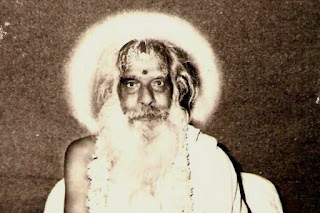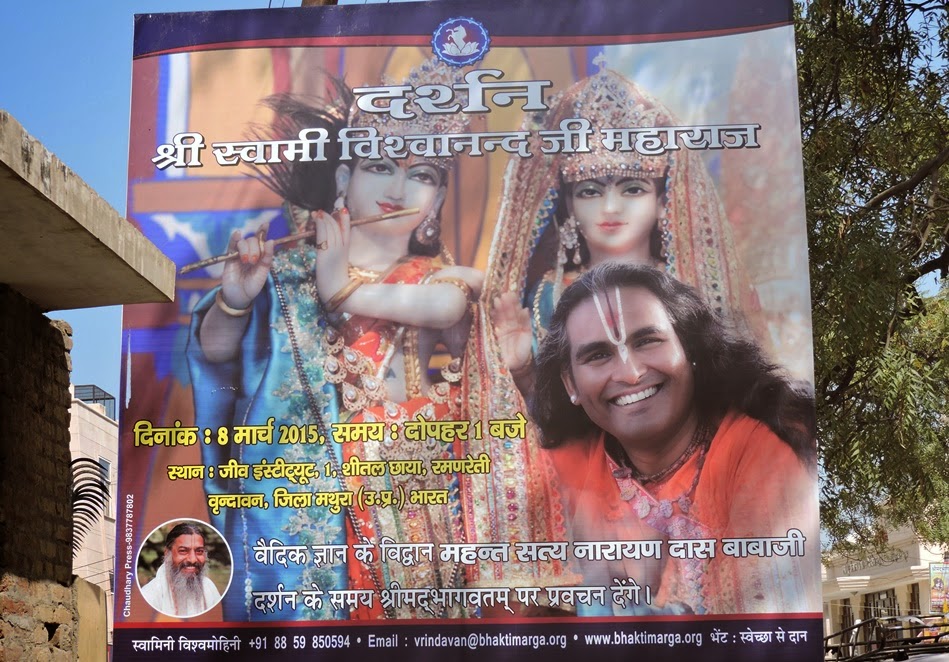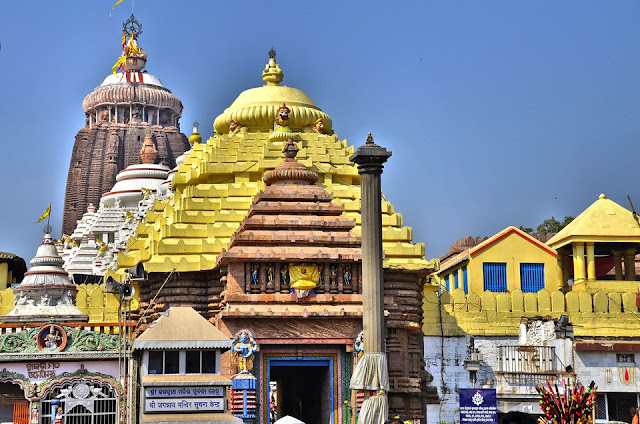Prabhu Datt Brahmachari
Many of Vrindavan’s scholars and sants gathered at the Bhava Sadhana Ashram in Gaura Nagar in order to offer homage to Prabhudatta Brahmachari in a special Guru Puja celebration. Haribol Baba recalled the role that Brahmachariji played in the anti-cow slaughter movement. As a result of his leadership, those devoted to Gomata were united in their efforts to end the mistreatment of cows. Many others remembered the contributions of Prabhudatt Brahmachari to the cause of Hindu nationalism.
The following account of Prabhudatt Brahmachari’s life is taken from several sources, but primarily from G. Kamesh’s Athato blog.
Prabhudatt Brahmachari was born in 1885 to a poor Brahmin family in a village in Aligarh district. He took a deep interest in Sanskrit studies early in his life and left home to study in various Gurukula including ones in Mathura and Vrindavan, finally ending up in Varanasi where Swami Karpatri Maharaj was one of his co-students. It was when still a young student that he made a lifelong vow of celibacy.
He was also drawn by the fire of the freedom struggle and became a follower of Mahatma Gandhi. He jumped into the fight for independence, going through the ritual of being jailed by the British. One of his prison mates was Jawaharlal Nehru himself. The irony is that he would later stand against Jawaharlal Nehru, in the first elections held in independent India.
Prabhudatt Ji was deeply spiritual, and undertook tremendous tapasya, right from his early years. He became a wanderer, and met many sages, including the great sages Oriya Baba and Hari Baba. He was deeply inspired by these two saints, and took every opportunity to take their guidance. Fired with dispassion, he decided to go away to Himalayas and not return until he had attained the supreme state of spiritual realization.
Oriya Babaji, recognizing this fire in him, encouraged him by showing him a picture he had of the Buddha. In that picture, Buddha was seen in almost skeletal state – his body completely wasted by the intensity of tapasya. Showing him that picture, Baba recited a related shloka:
 ihāsane śuṣyatu me śarīraṁ
ihāsane śuṣyatu me śarīraṁtvag-asthi-māṁsaṁ vilayaṁ tu yāntu
aprāpya bodhaṁ bahu-kāla-durlabhaṁ
ihāsanān naiva samuccaliṣye
In this seat, (where I do tapasya), well may my body dry up, my flesh and bones decay; But without attaining Self-Knowledge, which is extremely difficult to obtain even after eons, I shall not stir from this seat, whatever it takes. (Lalita-vistāra 19.57)
Taking this guidance, Prabhudatt ji left for the Himalayas. But after serious tapasya he became very ill and could no longer continue. Breaking his resolve, he returned to the plains, and going to Oriya Baba, he conveyed his disappointment. Baba was a jnani who could gaze into one’s heart and see such things as eyes of flesh do not see. He was kindness itself, and said, “No problem. In failure, the seeds of success lie hidden. You have a predilection for reading and writing. Go and write books.”
And so began the writing life of Prabhudutt Ji. And what a library he has written! Starting with the life story about Chaitanya Mahaprabhu (Sri Sri Chaitanya Charitavali), he went on to write on a whole range of subjects. His magnum opus is Bhagavati Katha. This is a series of 118 parts, each of which is 200 to 250 pages long. The first 68 parts are a rendering of Srimad Bhagavatam in traditional Hindi (Vraja bhasha), including translations and commentaries on key verses of Bhagavatam. Parts 69-74 of the series contain a commentary on Bhagavad Gita. Parts 74 to 106 contains commentaries on 191 upanishads. Imagine Perhaps no one else in history has done commentaries on as many Upanishads. Parts 107 to 118 contain explanations of different schools of Indian philosophy and a commentary on Brahma Sutra.
For writing this magnum opus, he opted for complete solitude. Delegating all his secular work to others, he acquired a houseboat which he anchored in the middle of Ganga river. And there he worked undisturbed, focused fully on his writing work. What a tapasya!
The Bhagavati Katha is respected as a great spiritual classic. The Braja language verses are sung with devotion even today at Prabhudatt Ji’s temple of Hanuman in Vasant Gaon, New Delhi.
Swami Prabhudatt Brahmachari’s main Asram is in Jhusi, near Allahabad, where he is said to have done sadhana of the Gayatri Mantra, standing in a state of samadhi in the waters of Ganga …. In this ashram, he held vibrant Nama Samkirtan festivals that were attended by some of the greatest contemporary sages of North India.
The great sage (Maharajshri) Swami Akhandananda Saraswati has written in his book Paavan Prasang, that he considered Swami Prabhudatt Brahmachari to be the one who was inspired him to become a public narrator of spiritual Katha. And those in the know recognize that it is to Maharajshri that we owe, in a very large part, the traditions of Bhagavata Katha in the form that we see now, all over India.
He became close to Golwalker, the founder of the RSS, in early 1950. Golwalker persuaded him to stand against Nehru on the cow protection platform and against the Hindu Code Bill. So in the first elections held in the Indian Republic in 1951, he openly challenged Jawaharlal Nehru’s election to the 1st Lok Sabha from the Allahabad constituency. This he did even though he had taken a vow of silence earlier that year.
He contested as an independent supported by ultra conservative Hindu groups like Swami Karpatri’s Akhil Bharatiya Ram Rajya Parishad and the All India Hindu Mahasabha. They had joined hands on one common platform: all were virulently opposed to Nehru’s Hindu Code Bill which sought to make sweeping reforms in inheritance, property and marriage laws for Hindus.
It was an amazing campaign, recorded in great detail by the January 28, 1952 issue of TIME magazine. Describing the Swami as one “who wears a luxuriant grey beard, orange-and-red-rimmed spectacles, a saffron robe and a long white loincloth,” the article states, “Holy Man Brahmachari toured Nehru’s constituency in a 1931 Dodge sedan accompanied by a troupe of Hindu singers. To the chanting of Hindu psalms, he danced on the platform, rhythmically tapping a pair of small brass cymbals. A disciple read from a pamphlet he had written.”
The article quotes from one such pamphlet: “Nehru,” he said, is a ‘black Englishman [who] studied in the West… The Hindu Code Bill will ruin religion, confuse castes, split every family, pit brothers against sisters and profit only lawyers.”
Needless to say, Nehru trounced him by a huge margin. The swami, who had taken a vow of silence and therefore resorted to writing what he wanted to say, justified his decision to jump into the electoral fray. “If today I participate in an election, it’s only because my innermost voice bids me to do so,” he wrote – Time magazine noted cynically – “with his Sheaffer fountain pen.”
He lost the election all right, but never lost his sense of political purpose. One of the most important causes that seized his heart was the protection of cows.

Prabhudatt Brahmachari in his Vrindavan ashram in the early 60’s. Deendayal Upadhyay, a founder of the Jana Sangh party and M.S. Golwalker, founder of the RSS are in the photo.
Brahmachari was one of the leaders of the movement against cow-slaughter in India. This became a life-long battle for him with the powers that be. He toured the length and breadth of the country for his campaign. In 1966, he formed SGMS (Sarvadaliya Gorakshana Maha-abhiyan Samiti or “All Party Cow Protection Movement”) which included people from all parties, even some Congressmen. He announced that a huge Satyagraha would be held on 7th November 1966, followed by a hunger strike. It is estimated that lakhs of people came to Delhi for this Satyagraha.
Sadly, the situation turned out of control, there were reports of vandalism, police resorted to firing, resulting in six or seven sadhus dying, and many were imprisoned. The Home Minister, Gulzari Lal Nanda, had to resign his post.
In 1967 he went on an indefinite fast on the issue of cow slaughter. He broke the fast after 80 days after Government intervened and gave some assurances.
Near the end of his life Sri Brahmachariji established a Hanuman temple in the Basant Gaon Sanskrit school premises. He uses to state that Sri Hanuman is the ‘kotwal’ (guardian) of India’s capital city. He had conceived a huge statue of Hanuman for this. He had it carved in Karkala, a place near Udipi by and with the help of Vrindavan’s Shripada Baba had it brought from Karkala to Delhi by special railway wagon. This story is quite an epic, and you can read about it on Kamesh’s Athato blog.
Shortly after the Hanuman image had been installed and the Prayag Magh mela in 1990, Brahmachariji came away to Sunrakh village, near Vrindavan, where he had renovated the ashram of Saubhari Rishi, in whose lineage he had been born. A celebration had been organized there, and Brahmachariji, even though in failing health, attended it.
After that, he came away to his ashram in Vrindavan, and his health was fast deteriorating. It was the second week of March, 1990. Devraha Baba would send one of his disciples to enquire about Brahmachariji’s health every hour, or even several times an hour – so critical was Brahmachariji’s condition. Baba would send medicine for him, but Brahmachariji would not take any. He had but one strong desire left, to go to his Hanuman in Delhi. Bowing to his will, his devotees brought him to Delhi. He arrived at the Basant Gaon Ashram in the evening.
Seated in front of Hanuman, he gazed at the Lord, his eyes streaming non-stop. Then he asked to be taken on a parikrama (circling) of the murti, even as he sat on his chair and entered the samadhi state. The next morning, at dawn, he merged into Golok Dham. The date was 11th March 1990.
It is said that Prabhudatt Brahmachari had four deep desires:
- To build a temple of Hanuman in Delhi, with a 40 foot tall Hanuman murti
- To build a temple of Vishnu (60 foot tall murti) in Indraprastha (Delhi – perhaps the Purna kila region)
- To put an end to cow slaughter
- Release of Ram Janma bhoomi






Comments
My person agrees with the words of Mahātmā Mohandas Karamchand Gandhi:
"non-cooperation with evil is as much a duty as is cooperation with good"
See pages 205-208 of 'The Gandhi Reader: A Sourcebook of His Life and Writings':
https://books.google.is/books?id=pjN3jZQ74AoC&pg=PA205&lpg=PA205&dq=%22Non-cooperation+with+evil+is+as+much+a+duty+as+is+cooperation+with+good%22++mahatma+gandhi&source=bl&ots=twOpCZwg_o&sig=iiqFC4G_k2y3ejmCuB6lXXcsTq0&hl=en&sa=X&ved=0ahUKEwiX6LOdztjTAhUGIcAKHXt4DYkQ6AEIWDAJ#v=onepage&q=%22Non-cooperation%20with%20evil%20is%20as%20much%20a%20duty%20as%20is%20cooperation%20with%20good%22%20%20mahatma%20gandhi&f=true